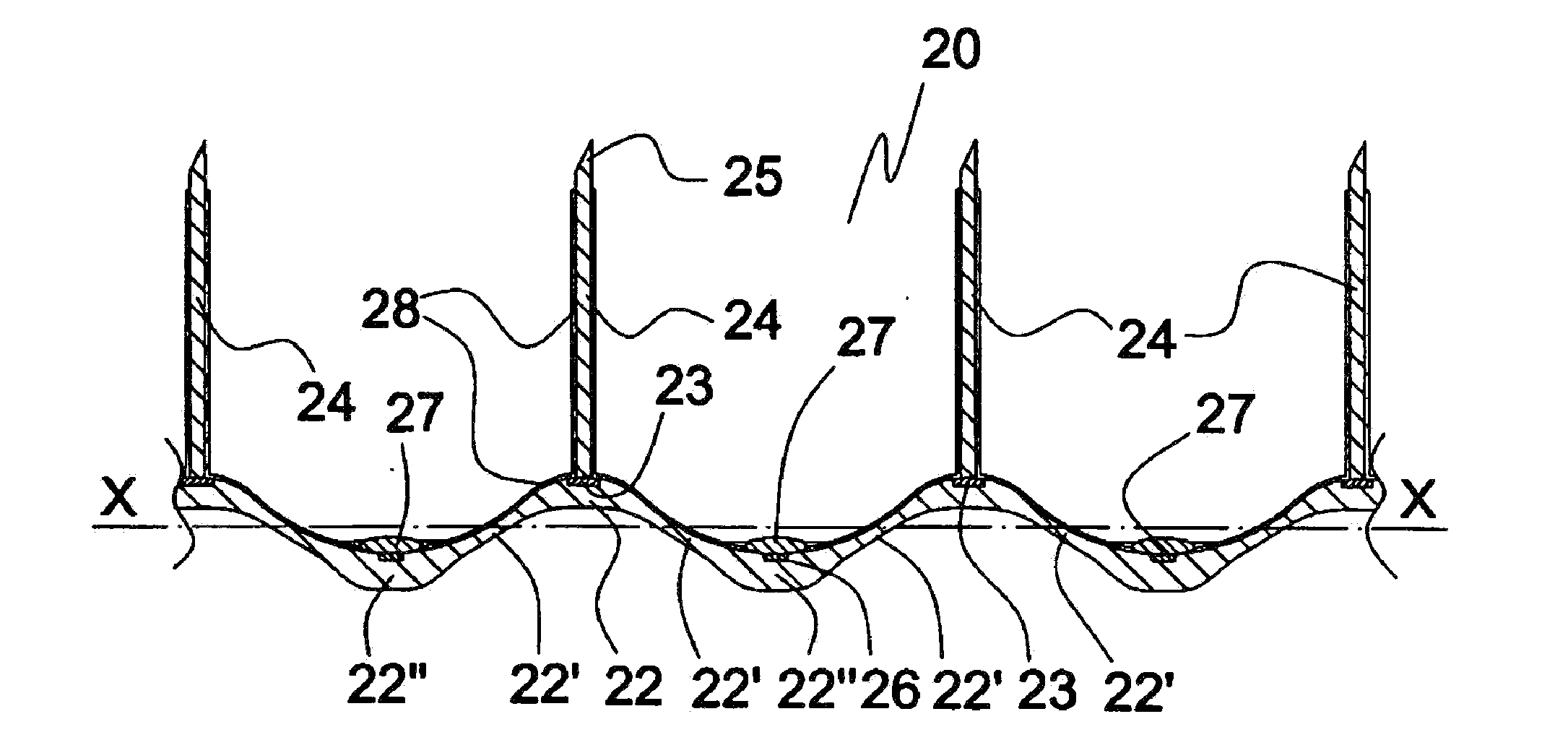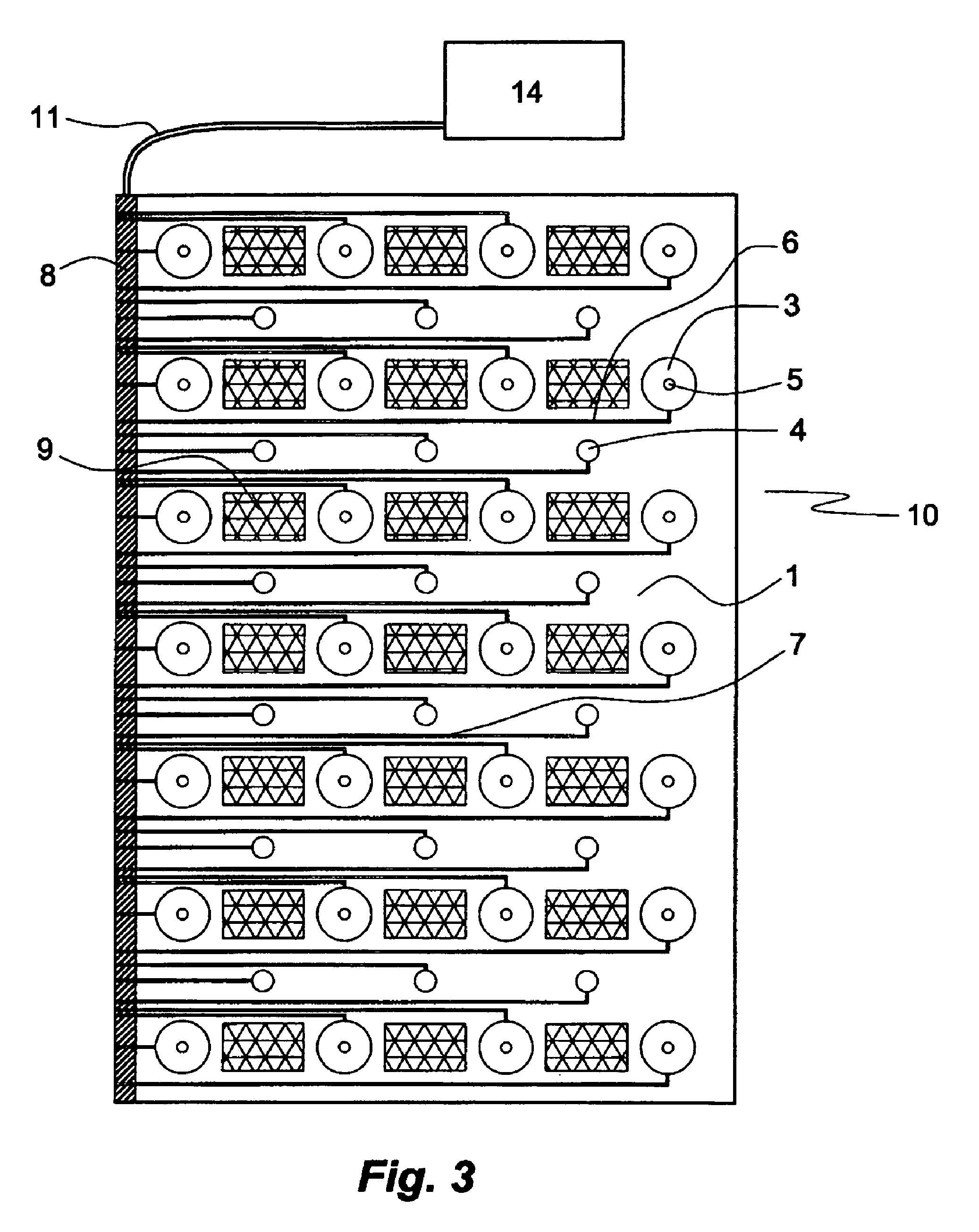Method for electrical stimulation of cutaneous sensory receptors
a technology of electrical stimulation and sensory receptors, which is applied in the field of electrode plates for electrical stimulation of cutaneous sensory receptors, can solve the problems of high threshold current needed to activate c fibers, unsuitable for stimulation of unmyelinated fibers classified as c fibers, and inability to tolerate, so as to increase the pressure on the electrodes, and speed up the healing of skin wounds.
- Summary
- Abstract
- Description
- Claims
- Application Information
AI Technical Summary
Benefits of technology
Problems solved by technology
Method used
Image
Examples
example 1
Embodiments of the Electrode Plate of the Invention
[0054]A first embodiment of the electrode plate of the invention is illustrated in FIGS. 1 and 3. The flat electrode plate 10 comprises a plate element 1 of a polymer material carrying, on its front face, a rectangular array of NL electrodes 2, 3, 5, each comprising a base 3 and an electrode element 2 with a pointed tip 5, and CP electrodes 4, in which rows U, etc., cf FIG. 6, four NL electrodes 2, 3, 5, are interspaced with rows u, etc., cf FIG. 6, of CP electrodes 4, each comprising three electrodes, in a manner that each CP electrode 4 is equidistant from two pairs of NL electrodes 2, 3, 5 in neighboring rows. To provide for consecutive stimulation rows or columns of NL and CP electrodes can be electrically coupled but it is equally possible to independently stimulate any desired combination of electrodes of the same kind and even each individual electrode (FIG. 3) by arranging corresponding electrical connections, such as in for...
example ii
Control of the Electrode Plate by Stimulator
[0072]In one embodiment of the invention electrically conductive straps, bonded to a thin and flexible sheet of for example polyester, are used to connect the CP and / or NL electrodes to a multi-channel stimulator. These straps are electrically insulated, by e.g. a plastic non-conductive film, except at the contact places for the electrodes and the multi-channel stimulator. In another embodiment, thin electrically conducting wires attached to the electrode plate of the invention are used to connect the CP and / or NL electrodes with a stimulator. The straps or wires are electrically insulated except at their free ends disposed at a circumferential side wall of electrode plate for easy connection with an external multi-channel stimulator (stimulating unit).
[0073]In a preferred embodiment the adhesive patches are made of electrically conductive material. The adhesive patches are then in contact with the CP electrodes on the plate which are, in ...
example 3
Venting Perforations
[0074]The electrode plate of the invention of polymer material can be provided with perforations providing communication between its front and rear faces to allow moisture exuded from the skin to evaporate. Preferably from 1% to 30% of surface of the front and rear faces are covered by the perforations. Alternatively, the polymer material from which the main structure of the electrode plate is made, such as polyurethane with open pores, is permeable to water vapour.
PUM
 Login to View More
Login to View More Abstract
Description
Claims
Application Information
 Login to View More
Login to View More - R&D
- Intellectual Property
- Life Sciences
- Materials
- Tech Scout
- Unparalleled Data Quality
- Higher Quality Content
- 60% Fewer Hallucinations
Browse by: Latest US Patents, China's latest patents, Technical Efficacy Thesaurus, Application Domain, Technology Topic, Popular Technical Reports.
© 2025 PatSnap. All rights reserved.Legal|Privacy policy|Modern Slavery Act Transparency Statement|Sitemap|About US| Contact US: help@patsnap.com



